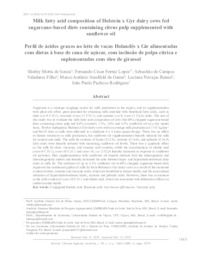Milk fatty acid composition of Holstein x Gyr dairy cows fed sugarcane-based diets containing citrus pulp supplemented with sunflower oil.
Milk fatty acid composition of Holstein x Gyr dairy cows fed sugarcane-based diets containing citrus pulp supplemented with sunflower oil.
Autoria: SOUZA, S. M. DE; LOPES, F. C. F.; VALADARES FILHO, S. DE C.; GAMA, M. A. S. da; RENNÓ, L. N.; RODRIGUES, J. P. P.
Resumo: Sugarcane is a strategic roughage source for milk production in the tropics, and its supplementation with plant oils offers great potential for obtaining milk enriched with beneficial fatty acids, such as oleic (cis-9 C18:1), vaccenic (trans-11 C18:1), and rumenic (cis-9, trans-11 CLA) acids. The aim of this study was to evaluate the milk fatty acid composition of cows fed 60% chopped sugarcane-based diets containing citrus pulp and 0.0% (control), 1.5%, 3.0% and 4.5% sunflower oil on a dry matter basis. Twelve multiparous Holstein x Gyr dairy cows with an average milk production of 17±5 kg day-1 and 96±25 days in milk were allocated in a triplicate 4 x 4 Latin square design. There was no effect of dietary treatment on milk production, but sunflower oil supplementation linearly reduced the milk fat content and yield. The milk fat contents of lauric (C12:0), myristic (C14:0), and palmitic (C16:0) fatty acids were linearly reduced with increasing sunflower oil levels. There was a quadratic effect on the milk fat oleic, vaccenic, and rumenic acid contents, while the concentrations of elaidic acid (trans-9 C18:1), trans-10 C18:1 and trans-10, cis-12 CLA linearly increased in response to sunflower oil inclusion. Diet supplementation with sunflower oil linearly reduced both the atherogenicity and thrombogenicity indices and linearly increased the ratio between hypo- and hypercholesterolemic fatty acids in milk fat. The inclusion of up to 4.5% sunflower oil in 60% chopped sugarcane-based diets improved the nutritional quality of milk fat from Holstein x Gyr dairy cows as a result of the increased content of oleic, rumenic and vaccenic acids, which are beneficial to human health, and the concomitant reduction of hypercholesterolemic lauric, myristic and palmitic acids. However, there was an increase in the milk content of trans-10 C18:1 and elaidic acid, which are associated with deleterious effects on cardiovascular health.
Ano de publicação: 2019
Tipo de publicação: Artigo de periódico
Unidade: Embrapa Gado de Leite
Palavras-chave: Conjugated linoleic acid, Rumenic acid, Saccharum Officinarum, Vaccenic acid
Observações
1 - Por padrão são exibidas publicações dos últimos 20 anos. Para encontrar publicações mais antigas, configure o filtro ano de publicação, colocando o ano a partir do qual você deseja encontrar publicações. O filtro está na coluna da esquerda na busca acima.
2 - Para ler algumas publicações da Embrapa (apenas as que estão em formato ePub), é necessário ter, no celular ou computador, um desses softwares gratuitos. Sistemas Android: Google Play Livros; IOS: iBooks; Windows e Linux: software Calibre.
Acesse outras publicações
Acesse a Base de Dados da Pesquisa Agropecuária (BDPA) para consultar o acervo completo das bibliotecas da Embrapa.

